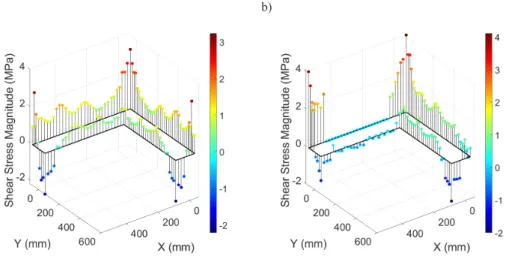Nonlinear finite element analysis of punching shear strength of reinforced concrete slabs supported on L-shaped columns
Full text
Figure
![Fig. 1. Critical perimeters assumed in ACI 318-19 [5] and Eurocode 2 [6]: a) around L-shaped columns, b) shear-reinforced connection with cruciform layout](https://thumb-us.123doks.com/thumbv2/123dok_us/10940046.2982666/3.722.183.559.212.444/critical-perimeters-assumed-eurocode-columns-reinforced-connection-cruciform.webp)
![Fig. 2. Slab-column specimens studied and critical perimeters used to calculate capacities according to ACI 318-19 [5] and Eurocode 2 [6] (specimen without opening, L1x6-0 not shown)](https://thumb-us.123doks.com/thumbv2/123dok_us/10940046.2982666/4.722.97.608.522.642/specimens-critical-perimeters-calculate-capacities-according-eurocode-specimen.webp)
![Table 1. Summary of slabs tested by Hawkins et al. [8] and FEA predictions. Source: own study Column Dimensions](https://thumb-us.123doks.com/thumbv2/123dok_us/10940046.2982666/5.722.90.644.620.915/table-summary-tested-hawkins-predictions-source-column-dimensions.webp)
![Fig. 3. a) Experimental specimen dimensions and loading [8], b) modified dimensions](https://thumb-us.123doks.com/thumbv2/123dok_us/10940046.2982666/6.722.82.633.77.330/fig-experimental-specimen-dimensions-loading-b-modified-dimensions.webp)
Related documents
I/We understand and agree that this application shall form part of any policy issued and that the Company requires that I/We obtain additional insured certificates of insurance
Thus, the analysis of the changes in CDS spreads gives support to the hypothesis that in the bailout period we have a risk shifting from banks to sovereign, in the post-bailout
Invoice shall be addressed to the correct ordering Alcoa Legal Entity Name as stated on the purchase order.. (Due to Tax Compliance reasons invoices issued for an incorrect
Table VII shows results for the following variables: average speed during the first 10% of path volume; average speed during the last 10% of path volume; average speed over all
The pathophysiology of this condition is based on immunopathological processes that are classified into 3 types: glomerulonephritis mediated by antibodies against the
John, eds., New Insights into Foreign Language Learning and Teaching (Frankfurt am Main, Peter Lang, 2004), in Studies in Second Language Acquisition 28:4 (Dec 2006). Dewaele,
Conclusion: Regarding the dietary aspect, a risk factor for MS was higher intake of saturated fat, and protective factors were high diet variety and adequate fruit intake..
The inclusion criteria for family caregivers were adults aged 18 years and older; self-identified as a primary caregiver that lived with the survivor and provided unpaid


